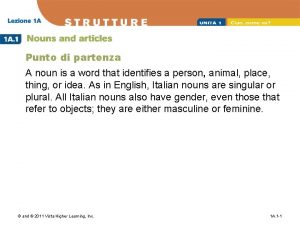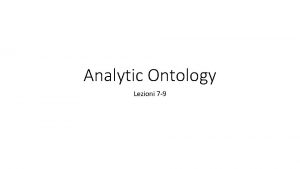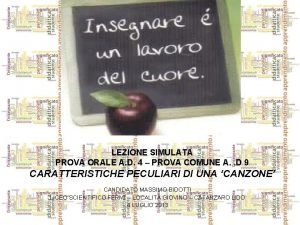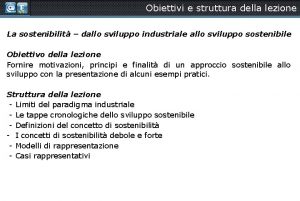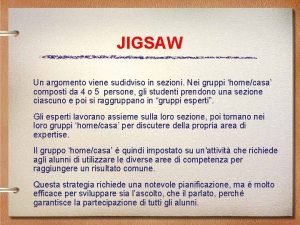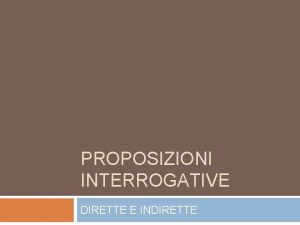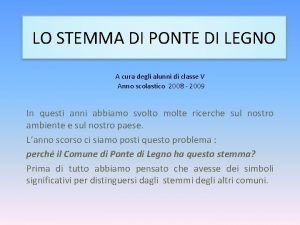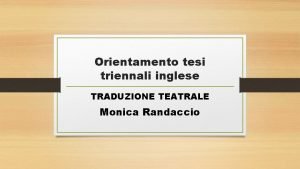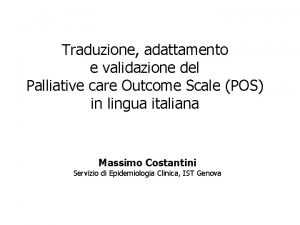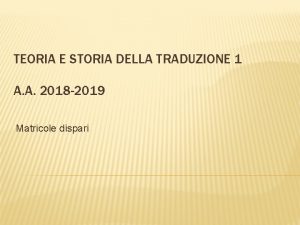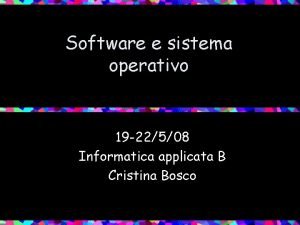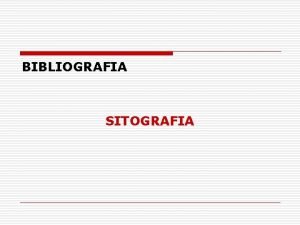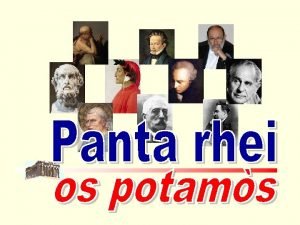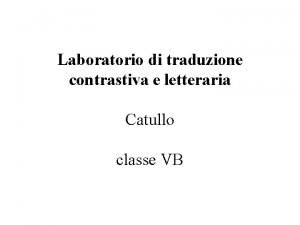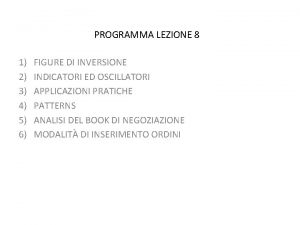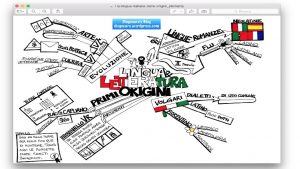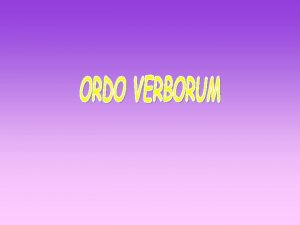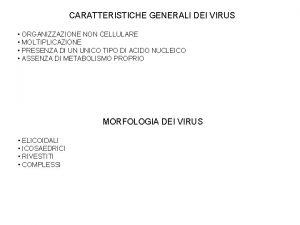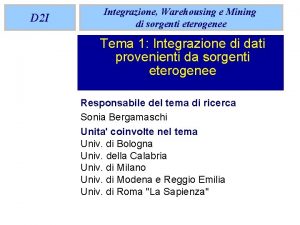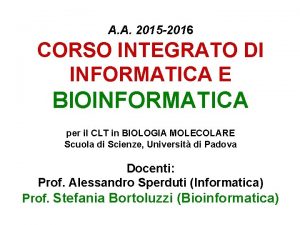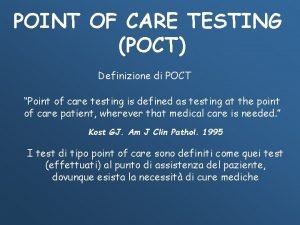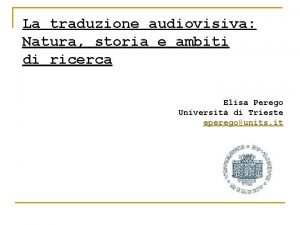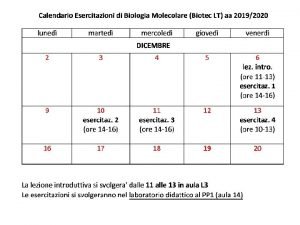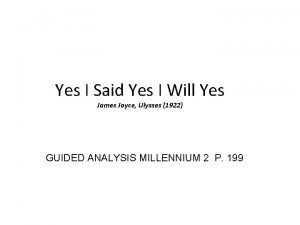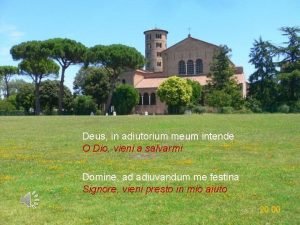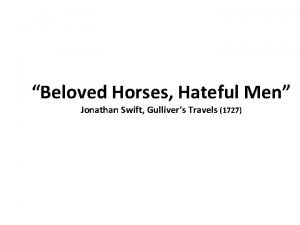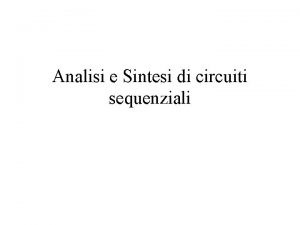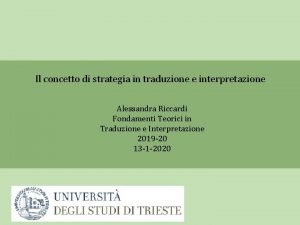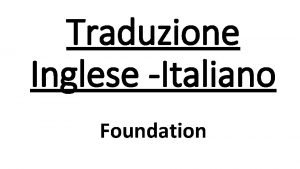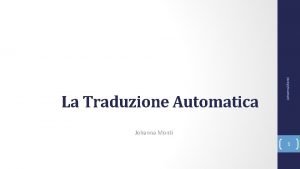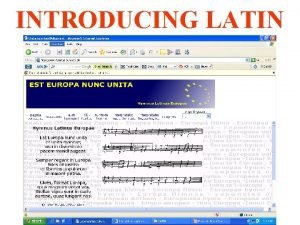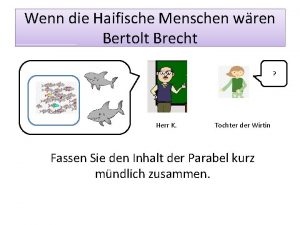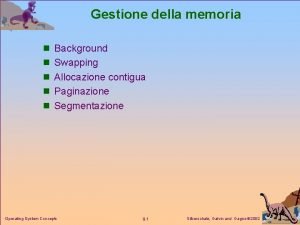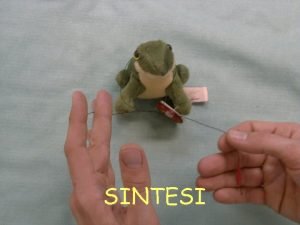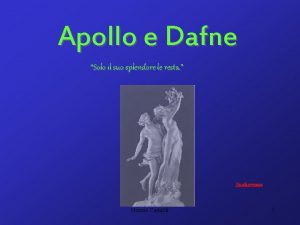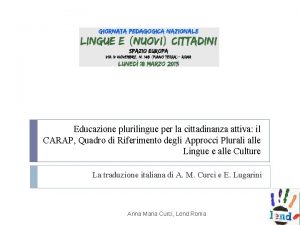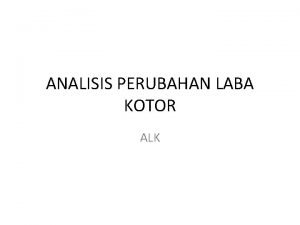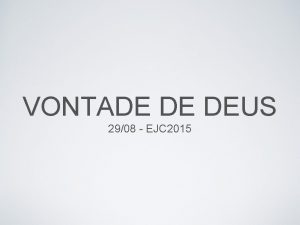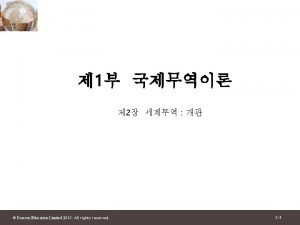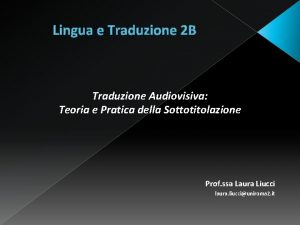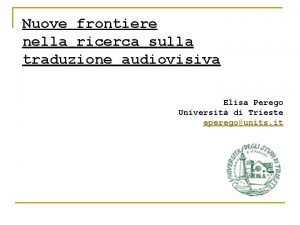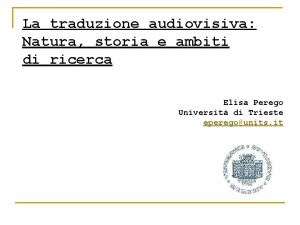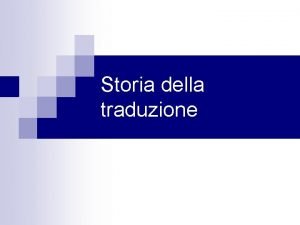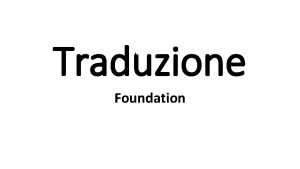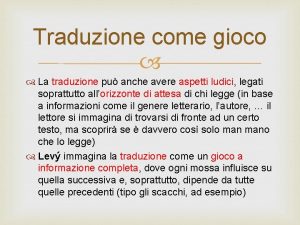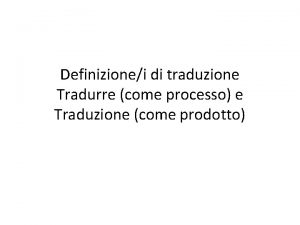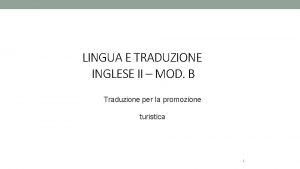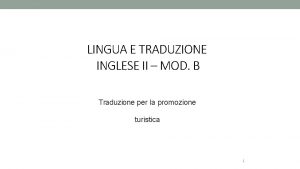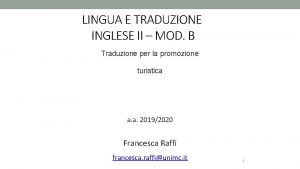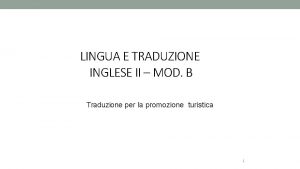Traduzione audiovisiva a a 2015 2016 Lezione 1

































































- Slides: 65

Traduzione audiovisiva a. a. 2015 -2016 Lezione 1

Accessibility 3. 4. Audiodescription for the Blind Translation of AD … and the texts that emerge from these processes.

Audiovisual Translation (AVT) Can be seen as giving an audience access to foreign language products through adaptation for dubbing, subtitling, surtitling voiceover, simultaneous translation, real time subtitling etc. These genres all involve some textual change in mode, information structure and flow or register in general, and linguistic change through processes of condensation, paraphrase, etc.

Cultural Access The translation of films is also considered to have a cultural role in the presenting of different cultures via linguistic means, thereby giving access to different mores and hopefully narrowing the gaps that exist in intercultural misunderstanding.

However, the extent to which cultural values are accessed by viewers through screen translation is a complex question. Translation specialists point to: l “lingua-cultural drops in translational voltage” (Antonini & Chiaro, 2005: 39) TV series like ‘The Simpsons’, ‘Six Feet Under’, ‘Friends’, etc. seem to be highly culture-bound and extremely difficult to translate.

…but how much does it matter? Quaglio wrote a whole book on the language of ‘Friends’, showing the inconsistencies, and pointing to the American-centredness of the show. … but it is extremely popular everywhere.

As Mossop says “The translator becomes the 'motivator' behind the ideas expressed in the translation, but he/she may be either 'loyal' (adding or subtracting in the spirit of the source as they see it) or 'disloyal' (engaging in his/her own writing project). A reworking of the traditional distinction between translating and adapting is proposed, to shed light on the distinction between what someone wrote and what they might have written. ”

And so… … access is provided via audiovisual translation (AVT) and even the most seemingly difficult audiovisual texts can be translated and understood, even if not exactly in the way initially intended.

extension of AVT nowadays room is to be found for individual needs and circumstances … indeed, in the field of audiovisual translation, greater attention is being paid to the varying needs of people who cannot access the original productions for whatever reason… … to the deaf and hard of hearing and to the blind and sight impaired.

The situation regarding the blind (audiodescription was invented by Margaret and Cody Pfanstiehl in 1981) United States l Telecommunications Act 1996 led to recognition of audiodescription. Good progress has been made in the UK, Germany and Spain Italy (1. 5 m blind or sight-impaired) Parliamentary Hearing on AD accessibility 2010

AD both intralingual and interlingual Audiodescription in the listener’s own language; Translated audiodescription for films in a foreign language, including audiosubtitling.

professional training l l the guidelines that have been adopted are rarely based on empirical research, in most cases being the result of experience, common sense and personal preferences What is more, where university classes and training sessions are taught, teaching methods are not uniform across providers, and several practitioners self-teach the skills that are required by their work, especially as far as accessibility services are concerned (Díaz 2007, 2009).

American Council of the Blind Annual Audiodescription Project ‘Describers tell it like it is’ – Guests l l Actors Lawyers Attorney General Federal Communication Commission Linguists? ? Translators? ? (no meta-reflection) l

(B) AUDIODESCRIPTION l What is Audiodescription? “an enabling service for blind and partially sighted audiences* (…) describing clearly, vividly and succinctly what is happening on screen or theatre stage in the silent intervals between progamme commentary or dialogue – in order to convey the principal visual elements of a production. ” (Royal National Institute of the Blind) “the visual made verbal” Joel Snyder

Five channels of information in ‘cinematic scriptwriting’ (Millard 2010) l l l Visual image Print audiodescription Speech (Dialogue)* Music Sounds auditory *Speech = verbal play Dialogue propels plot

‘clearly’ l l l Avoidance of obscure vocabulary and jargon. Avoidance of clashes with dialogue and other sounds. Avoidance of complicated sentences with subordinate clauses

‘vividly’ l l Use of ‘colourful’ adjectives and adverbs where appropriate Exploitation of verb variations: l l Eg. Walk – stagger, stroll, stride, etc. Use of stress, rhythm, intonation, etc…

‘succinctly’ l l l Remember that audiodescription ADDS to the cognitive load (cf. subtitles) Cluttered descriptions distract (studies show that humans can only remember three things at a time) Time is of the essence! (usually) cf. Penelope Cruz’s song in ‘Volver’ where the description (and translation of the subtitles) has to be fitted into pauses in the singing.

The Audience l As with the Deaf, the audiodescriber needs a thorough knowledge of the needs of a visually impaired audience. Royal Institute for the Blind, etc. collaborate with television producers. In Trieste we collaborate with the ‘Istituto Rittmeyer per i Ciechi’ and ‘Senza Barriere’.

The description includes l l l l Characters in the scene Location of the scene and perspective Who is speaking What the characters are doing What the characters are wearing Facial expressions and body language Text shown on objects or as subtitles Colours § all recontextualised

Description (of static picture) l l Describing something off-line (without seeing it, and from memory) we retell using a certain format. “When we make meaning we always simultaneously construct a presentation of some state of affairs, orient to the presentation and orient to others, and in doing so create an organised structure of related elements. ”

F. G. Cf. presentational orientational organisational ideational interpersonal textual

Off-line description l l l l No time constraints Natural expression Metacomments Judgements Summarising Possibility of error Omissions not dictated by relevance

On-line description (on seeing) l l l Natural expression Details Lists Less uncertainty Spatially oriented Localised (in the foreground…)

Audiodescription (dynamic texts) l l l l Time constraints! Not natural expression Detailed Less uncertain Spatial orientation (and) Temporal orientation Judgements, appraisal? ?

Difference between description and audiodescription l l A student in Trieste audiodescribed a short advertisement for Martini. limited timespan

Martini ad

Version 1: reading time 60 seconds l l l l l l Gwyneth Paltrow è seduta su un letto, di spalle, nuda. Si infila una camicia bianca maschile. (Where are you going? ) Si gira verso l’uomo che giace sul letto, e gli lancia uno sguardo complice e un sorriso ammiccante. Si affaccia sul corridoio, è in un albergo. Percorre il corridoio di soppiatto, con addosso solo la camicia bianca. Si trova al bar dell’albergo. Scende tre scalini. Scavalca il bancone del bar. Ha ai piedi un paio di sandali neri con il tacco alto. Appoggia due bicchieri vuoti sopra il bancone. Prende la bottiglia di Martini da dietro le sue spalle. I bicchieri sono ora pieni di ghiaccio. Versa il Martini nei bicchieri. Aggiunge uno spicchio di limone in ciascun bicchiere. Afferra la bottiglia e si volta per rimetterla al suo posto. Un uomo e una donna, giovani ed eleganti, si avvicinano al bancone. Gwyneth Paltrow si gira verso di loro. I due giovani hanno preso i due bicchieri che erano sul banco, si voltano e fanno per andarsene. (Good night!) Gwyneth Paltrow abbassa lo sguardo con un’aria di ironica rassegnazione. I due giovani si voltano verso di lei e l’uomo si avvicina di nuovo al bancone. Gwyneth ha un’aria interrogativa. Lui porge una banconota. Gwyneth Paltrow sorride stupita. Bottiglia di Martini in primo piano, logo in sovraimpressione. La mano di Gwyneth afferra un bicchiere e lo solleva. (My Martini, please) Sorride, guarda avanti a sé e si avvicina il bicchiere alle labbra. Beve.

Version 2: reading time 45 seconds. l l l l Gwyneth Paltrow è seduta su un letto, di spalle, nuda. Si infila una camicia bianca. (Where are you going? ) Si volta verso l’uomo che giace sul letto, sorride. Si affaccia sul corridoio dell’albergo, lo percorre di soppiatto. E’ al bar dell’albergo, l’arredamento è molto ricercato. Scavalca il bancone del bar. Ha ai piedi una paio di sandali neri con il tacco alto. Appoggia due bicchieri sul bancone. Si volta e prende una bottiglia di Martini. Riempie i bicchieri. Aggiunge una fetta di limone in ciascun bicchiere. Si volta per rimettere a posto la bottiglia. Un uomo e una donna, giovani ed eleganti, si avvicinano al bancone e afferrano i due bicchieri. Si voltano per andarsene. (Good night!) Gwyneth ha un’aria di ironica rassegnazione. L’uomo torna al bancone, e le porge una banconota. Gwyneth sorride stupita. Bottiglia in primo piano e logo del Martini. Una mano in secondo piano afferra un bicchiere. (My Martini, please) Gwyneth sorride, e beve.

Version 3: reading time 35 seconds l l l l Gwyneth Paltrow è seduta su un letto, di spalle, nuda. Si infila una camicia bianca. (Where are you going? ) Si volta verso l’uomo che giace sul letto, sorride. Esce di soppiatto dalla stanza. E’ al bar dell’albergo. Scavalca il bancone. Appoggia due bicchieri sul bancone. Si volta e prende una bottiglia di Martini. Riempie i bicchieri. Si volta per rimettere a posto la bottiglia. Un uomo e una donna, giovani ed eleganti, si avvicinano al bancone e afferrano i due bicchieri. Si allontanano. (Good night!) Gwyneth ha un’aria di ironica rassegnazione. L’uomo torna al bancone, e le porge una banconota. Gwyneth sorride stupita. Bottiglia e logo del Martini. Una mano afferra un bicchiere. (My Martini, please) Gwyneth sorride, e beve.

Version 4: reading time 30 seconds l l l l l (DEFINITIVE VERSION) Gwyneth Paltrow è seduta su un letto di albergo, di spalle, nuda. Si infila una camicia bianca. (Where are you going? ) Sorride complice all’uomo che giace accanto a lei. Esce di soppiatto dalla stanza. E’ al bar. Scavalca il bancone. Appoggia due bicchieri sul bancone. Prende una bottiglia di Martini e li riempie. Si volta per rimettere a posto la bottiglia. Una coppia giovane ed elegante si avvicina, afferra i due bicchieri e si allontana. (Good night!) Gwyneth ha un’aria seccata, ma ironica. L’uomo torna al bancone, e le porge una banconota. Gwyneth sorride stupita. Bottiglia e logo del Martini. Una mano afferra un bicchiere. (My Martini, please) Gwyneth sorride, e beve.

Apart from the merely visual … … there is much that lies behind the image: - cultural questions - film structures/conventions - interpretations/expectations of the audience

RANSOM l l l An ambulance speeds along a city street. In the distance the trees of Central Park. (AD) An ambulance speeds along an uptown Manhattan street near Central Park. (Vercauteren, 2010) (need to emphasise that this is rich, fashionable New York, though it is also necessary that the schemata be shared).

Appraisal l On-line describing also entails validity judgements, epistemic expressions, attitudinal meaning, etc. It is difficult to avoid interpreting from our own experience and expertise. l e. g. I think this is …. It seems there is a sort of… …and it is charming, lovely, amazing, etc.

BUT l This has been frowned upon in audiodescription. l GUIDANCE ON STANDARDS FOR AUDIO DESCRIPTION (ITC) “the best audiodescribers objectively recount the visual aspects of an image. Subjective or qualitative judgements or comment get in the way. ” l but there again…

Sad (Orero 2010) “the eyelids droop as the inner corners of the brows rise, the corners of the lips pull down, and the lower lip pushes up in a pout”

Do we want to reproduce the same experience… l … or do we want sometimes to use our better judgement, based on our knowledge of the film and our (and the audience’s) knowledge of the world. l Is it a question of “what you see” “what we think” “what they want”? (NOT to be patronised) l l l

Iconic vs. indexical, but don’t give too much away l l Eg. In the film ‘Gran Torino’ we see a copy of a hospital admittance form. This becomes important only at the end when the protagonist in effect lets himself be killed knowing that he is going to die anyway. anchoring

But what do we see? l l l Eye-tracking technology has provided a ‘window to the mind’ (d’Ydewalle, Perego, Kaltenbacher & Kaltenbacher). Fixations and saccades can be compared to verbal foci. So describe what you actually see. Fixations can be on objects, locations, directions, attributes, activities, etc. with different levels of specificity and different degrees of creativity. But what do viewers actually look at? What is foregrounded?

Video Marie Antoinette




Linguistic aspects: Theme l l l Audiodescription involves a particular use of language – present tense, solely declarative, vivid vocabulary, etc. It also displays particular theme choices and progression. All clauses are declarative, so often the subject is theme, often pronouns, predominantly, if not exclusively, third person.

Theme reiteration The English Patient l l l l 01: 04 A Red Cross troop train. A young French-Canadian nurse, Hana, adjusts the belt of her uniform. She walks into a carriage where wounded soldiers lie one above the other on bunks. (Passing between them) she stops beside a young man. 01: 04: 39 She bends over him. 01: 04: 45 She moves on between the bunks. 01: 04: 58 She joins her colleagues.

and tight anaphoric reference l l The horribly burned pilot has been found by nomads. Gently they cover his blackened flesh. He is barely alive. They investigate his belongings. .

Marked themes: non-finite clauses – shows the pre-planning typical of written language l l l l Passing between them, … Swathed in blankets, … Seated behind the pilot, … Standing behind a railing, … Forcing open a door, … Wearing a simple skirt, … Finishing his photography, …

Dialogue l l l We do and we are while we speak. But for the blind, characters in films speak their roles but cannot be seen ‘doing’ or ‘being’. Non-finite phrases provide that input succinctly.

Nominal groups (ellipsis) l l l l Bright white letters on a blue background. A pale gold background with a textured surface. A Red Cross troop train. The desert. An Army Red Cross camp. Italy, October 1946. An explosion on the road ahead. Morning. The Red Cross camp. Later. The monastery Dawn. An egg.

Theme in the AD of ‘The English Patient’ (7, 500 words) Nouns and noun groups Circumstantial l adjuncts of Time l adjuncts of Manner l adjuncts of Place l Pronouns (3° person) l Non finite clauses l 302 38 26 62 239 77

Theme in ‘The Traveller’s Story’ (Wilkie Collins) Nouns 152 Circumstantial l adjuncts of Time 61 l adjuncts of Manner 20 l adjuncts of Place 14 l Pronouns (1° person) 146 l Pronouns (3° person) 41 l Non finite clauses 6 l Imperatives 27 l Questions 21 l (existentials, minor clauses, interpersonals, vocatives) l

Theme In AD theme development is also, of course, contextualised by the dialogue. But the lack of existentials, minor clauses, interpersonals, vocatives, continuatives, exclamatives, etc. is striking.


But in AD translation what considerations come into play? l l l One consideration is not to translate and start from scratch. Another is to use the original AD as a template for all other translations. Another is to consider that different nationalities/cultures /languages may need different adaptations.

Cultural considerations The Pear Tree Project: Homogeneous groups of 20 people in twelve countries were asked to watch a short film and then write a description of what they saw. The texts were then analysed in terms of a number of parameters to determine whether subjects from different cultures with different languages prioritised different aspects. This would have implications for audiodescription and audiodesription translation.

variables l Direct or indirect reference to film l Verb tense l The fall of the child from the bicycle: ü ü l attribution of cause objects quoted Denomination of: ü ü The man picking the pears The group of three boys who help the fallen child

Pear Tree l l l l In this film you see a man picking pears… In the short movie you see a man who is picking pears… There is a farmer who is picking some pears… A man is picking pears… There is a farmer in the countryside who is picking some pears… We are in an outdoors… The first scene of the film shows a rather tall and sturdy man picking some pears…

Hierarchical Classification Procedure: dendrograms l Hierarchical classification (Cluster Analysis): l l l Single Linkage; Interval: Euclidean Distances; Cluster method: Nearest neighbour; Objects variables

Cartogramma - Occorrenze

Cartogramma - Tempo dei verbi

Cartogramma – Descrizione Raccoglitore di Pere Dato medio (tipologia di modalità/numero partecipanti gruppo) moltiplicato 100

Cartogramma – Descrizione Raccoglitore di Pere Dato medio (modalità-citazioni/numero partecipanti gruppo) moltiplicato 100

Video The Hours

The Grand Budapest Hotel

How is AD provided? l See Audio Description Services (DTG pp. 4860) (to be e-mailed) l Receiver Mix – audio stream contains only audio commentary. Integrate with original audio. Broadcast Mix – audio commentary already mixed with original audio. l
 La lezione della farfalla
La lezione della farfalla Esempio di lezione clil diritto
Esempio di lezione clil diritto Lezione masculine or feminine
Lezione masculine or feminine L'esperienza delle cose moderne e la lezione delle antique
L'esperienza delle cose moderne e la lezione delle antique Esperienza delle cose moderne e la lezione delle antique
Esperienza delle cose moderne e la lezione delle antique Lezione 7
Lezione 7 Lezione simulata
Lezione simulata Struttura della lezione
Struttura della lezione Esempi jigsaw
Esempi jigsaw Consecuzio temporum
Consecuzio temporum Pax evan tibi geli mar sta ce meus traduzione
Pax evan tibi geli mar sta ce meus traduzione Tesi in inglese
Tesi in inglese Traduttore italiano inglese
Traduttore italiano inglese Nusaf che significa
Nusaf che significa Array traduzione informatica
Array traduzione informatica Traduzione
Traduzione Hzl bilişim
Hzl bilişim Teoria e storia della traduzione
Teoria e storia della traduzione Vott a passa
Vott a passa Bootstrap traduzione informatica
Bootstrap traduzione informatica Sitografia in inglese
Sitografia in inglese Panta rei os potamos scritto in greco
Panta rei os potamos scritto in greco Ille mi par esse deo videtur traduzione
Ille mi par esse deo videtur traduzione Intertextuality examples in newspapers
Intertextuality examples in newspapers Lagging indicators traduzione
Lagging indicators traduzione Mappa concettuale lingue indoeuropee
Mappa concettuale lingue indoeuropee Testo plus side effects
Testo plus side effects Praebo latino
Praebo latino Concatamero
Concatamero Warehousing traduzione
Warehousing traduzione Dativo di effetto
Dativo di effetto Seed traduzione informatica
Seed traduzione informatica Poct definition
Poct definition Ham honge kamyab
Ham honge kamyab Am 12 dezember werther traduzione
Am 12 dezember werther traduzione Promene traduzione
Promene traduzione Gerundio come si traduce in latino
Gerundio come si traduce in latino Almacen traduzione
Almacen traduzione Rna
Rna Language traduzione
Language traduzione Yes james
Yes james Deus, in adiutorium meum intende
Deus, in adiutorium meum intende Tema del varco montale
Tema del varco montale Gulliver's travels horses
Gulliver's travels horses Automa di moore esempio
Automa di moore esempio Chunking traduzione
Chunking traduzione Traduzione
Traduzione Andra moi ennepe moussa polytropon
Andra moi ennepe moussa polytropon Foundation subjects traduzione
Foundation subjects traduzione Johanna monti
Johanna monti Disembedding traduzione
Disembedding traduzione Ipse ipsa ipsum traduzione
Ipse ipsa ipsum traduzione Vivat lingua
Vivat lingua Wenn die haifische menschen wären inhaltsangabe
Wenn die haifische menschen wären inhaltsangabe Swapping traduzione
Swapping traduzione Sewer slide traduzione
Sewer slide traduzione 0 pds suture
0 pds suture Primus amor phoebi daphne traduzione
Primus amor phoebi daphne traduzione Carap cos'è
Carap cos'è Perubahan laba kotor
Perubahan laba kotor 2015 ispsc
2015 ispsc Dementia 2015
Dementia 2015 Ejc 2015
Ejc 2015 Pearson education limited 2015
Pearson education limited 2015 2015 pearson education inc
2015 pearson education inc Management review iso 9001 version 2015 muster
Management review iso 9001 version 2015 muster


